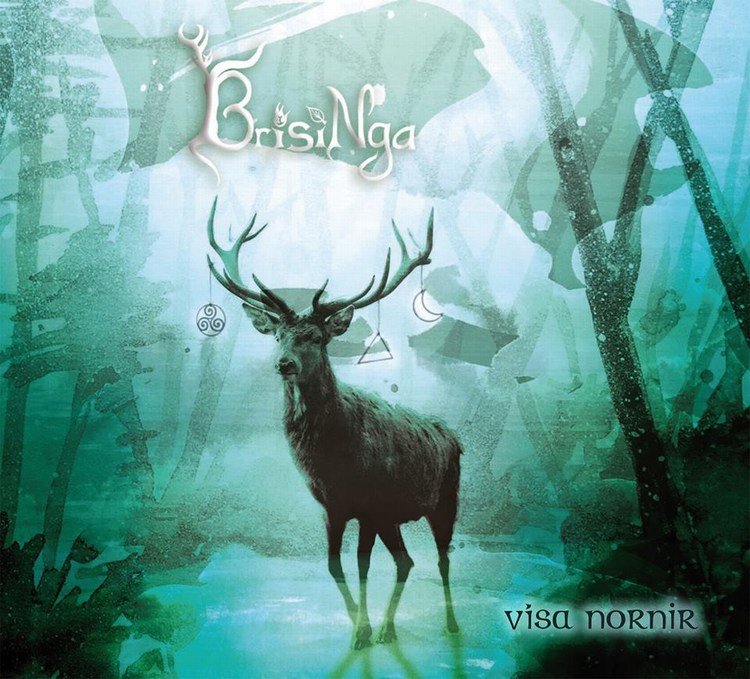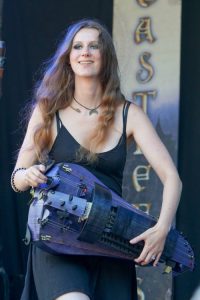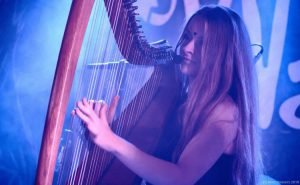
-”We musically fell in love.” That’s the heart warming way Brisinga‘s Fabi described meeting Fanny for the first time. It is also the best way to describe what happened to me while reviewing Brisinga’s debut CD Vísa Nornir. I musically fell in love with these talented ladies.
Brisinga bring together the best in pagan- , Nordic- and dream folk, and blend it into beautiful songs. They call it psychedelic folk. I think minimal Nordic folk is a better description, but either way Vísa Nornir is a lovely CD that I gladly recommend! But before I get into the music let ‘s give Fabi some time to introduce Brisinga a bit more.
 “At this point in time Brisinga is a duo. Myself on hurdy-gurdy, recorders, flutes and vocals and Fanny, who also sings and plays the harp. Brisinga started out as a fire and music show founded by Fanny and Johanna. Because of the fire element they chose a name coming from the
Edda.
It means something like fire, flame or light. Maybe you know that Freya had an amber necklace called
Brísingamen,
which she got from four dwarvs. How she got it is a intresting story in itself. Anyway the name Brisinga is based on that.
“At this point in time Brisinga is a duo. Myself on hurdy-gurdy, recorders, flutes and vocals and Fanny, who also sings and plays the harp. Brisinga started out as a fire and music show founded by Fanny and Johanna. Because of the fire element they chose a name coming from the
Edda.
It means something like fire, flame or light. Maybe you know that Freya had an amber necklace called
Brísingamen,
which she got from four dwarvs. How she got it is a intresting story in itself. Anyway the name Brisinga is based on that.In the end the fire thing didn’t work out so Johanna, -who played Bodhrán and percussion and sang backing vocals,- and Fanny decided to only focus on playing music. In the meantime I met Fanny in another project and we musically fell in love. We tried building a repertoire with folk covers, but we wrote so much music together that after a short while we left the covers behind us and focussed on our own songs instead.
We first visited the Dearworld studio in December 2015 to record an EP. But we got so inspired recording the EP that we wrote even more songs so we could make a whole CD. In winter 2016 we returned to the Dearworld studio once more and Vísa Nornir came out on April 11th 2017. In the summer of last year Johanna chose another path and now it’s only Fanny and me. Although sometimes we perform with a guest cello player, which complements our music really nicely we think.
Fanny and me both studied music at the same university in Germany, a fun fact is that Fanny studied in the Netherlands before that. Why did we choose folk music? Well we listened to very different music before it all began, but we both were fascinated by the sound of folk instruments. We wanted to play folk in a kind of minimalistic way as you can hear on the CD. Our newer songs are a bit more complex and have a different intention.”
Fabi ends her introduction of Brisinga with a YouTube link you find below in which the Brisingirls introduce themselves even more.
Vísa Nornir opens with Einsemd (solitude) And that’s exactly how it sounds. Fabi’s beautiful voice ringing out into the air as she is standing on a Nordic fjord. It can be seen as an intro, calming, preparing your mind for the music yet to come. The next song Cernunnos picks up as it was still part of Einsemd. It’s a dance based on a dream according to the booklet. And it starts with a lovely gentle harp piece, reminiscent of Omnia‘s The Naked Harp CD. Now with Brisinga making nature influenced pagan folk, using harp, hurdy-gurdy, bodhrán and overtone flutes, it’s really easy to make the Omnia connection and there are moments when they use the same musical techniques Stenny also use to create a mood. But there is a big difference in sound. The difference between day and… ….evening. Summer and Autumn. Where Omnia and other Dutch pagan bands enrich the music, add details in it to make it as cheerful and bright as a summer’s day, Brisinga tone the music down. Less is more. Just as the setting sun turns the sky into an orange flame and all things are turned down to their essential forms. Silhouettes against the warm orange sky. If you think of Dutch/German pagan bands like Omnia and Waldkauz as storytellers, then Brisinga’s music is poetry. It’s autumn, it’s red. Yellow. Tactile and Brown. Warm yet gentle. Calming yet strong. It’s beautiful.
 I have to say here that Brisinga found the perfect person,in Fieke van den Hurk, to record Vísa Nornir in the way they envisioned it. After the lovely gentle harp intro in Cernunnos, Fanny raises the speed into almost an Irish jig. The bodhrán joins in but in a very subtle way. It’s played ever so gently. The last to join in is Fabi. And the song becomes a beautiful duet between harp and hurdy-gurdy. Fabi plays her hurdy gurdy so gently, it sounds more like a cello than the normal loud almost’shouting’, medieval market instrument I’m used to hear.
I have to say here that Brisinga found the perfect person,in Fieke van den Hurk, to record Vísa Nornir in the way they envisioned it. After the lovely gentle harp intro in Cernunnos, Fanny raises the speed into almost an Irish jig. The bodhrán joins in but in a very subtle way. It’s played ever so gently. The last to join in is Fabi. And the song becomes a beautiful duet between harp and hurdy-gurdy. Fabi plays her hurdy gurdy so gently, it sounds more like a cello than the normal loud almost’shouting’, medieval market instrument I’m used to hear. Listen to Cernunnos with headphones and you can clearly hear every key being touched. I never thought I would say it but those ‘clicks’ sound beautiful. It becomes a bit of extra percussion in the music. So cleverly recorded by Fieke. Well done!
Vapaa Ja Villi is a Finnish song. The lyrics, as in most of the songs, are written by Fabi, and it is a duet of voices this time. Fanny and Fabi have beautiful voices that blend so well together. Vapaa Ja Villi is themed as a dance song again; three witches dancing in a forest. And those voices really dance. They dance around each other, high and low, up and down the Nordic night, around the treetops and into your ears.
 The Ones That Look Up To The Oaktrees is a medley of songs with an Irish feel. The first part Copper And Ocean features Fanny on harp and vocals. She has this deep warm, a bit hoarse voice that everybody would wish to have next to their bed to sing them to sleep. This first part reminds me of
Sinead O’Connor‘s
Last Day Of Our Acquaintance, especially with Fanny’s voice. Definitely a favourite part of Vísa Nornir for me.
The Ones That Look Up To The Oaktrees is a medley of songs with an Irish feel. The first part Copper And Ocean features Fanny on harp and vocals. She has this deep warm, a bit hoarse voice that everybody would wish to have next to their bed to sing them to sleep. This first part reminds me of
Sinead O’Connor‘s
Last Day Of Our Acquaintance, especially with Fanny’s voice. Definitely a favourite part of Vísa Nornir for me.
Which takes me straight to the most beautiful song on Vísa Nornir, Sinä Ja Minä. It’s a tribal song in the good tradition of Kati Ran‘s Suurin or Eivor‘s Trollabundin, and a stunning one.
According to the booklet it’s a hunting song inspired by Finnish mythology and it does have this hunting, daunting feel over it. Again the basis is really simple. Two voices in harmony together and a single drum. Beauty doesn’t need more. It’s the harp and the overtone flute that then take you deep into the Nordic night. Running with the wolves as the northern light expand into their full grandeur over the dark sky. Really, a stunner of a song!
Sol øg Rog brings you right down again. So small, so tender. If you want to understand what Brisinga ment when they said they want to bring a minimalistic feel to their folk music, this is it. This is Nordic pagan folk meets dreamfolk. This is what makes Brisinga stand out from the other pagan folk bands. It’s their signature upon the genre,
The following song Samhain starts equally beautifully. It’s a word I use a lot in this review, beautiful, but it’s the only way I can describe Brisinga’s music. It’s beautiful how the song doesn’t really start, no the harp just appears out of the silence.
Módir Min is an Icelandic ghost story about abandoned children in the freezing cold, dedicated to Brisinga’s beloved mothers. With the piano-like harp and angelic voice of Fabi it reminds me a lot of Martine Kraft‘s Sølje intro. And, here comes that word again, it’s just beautiful.
As Fanny’s harp gently leads me into the very last song, I realise I don’t want to talk about the music anymore.
I just want to listen to it.
Feel it.
Absorb it.
The sentences stop,
they become words,
single words,
voices,
harmonic,
soothing.
As they whisper,
softly,
calm,
is my mind
Cliff
Editor: Diane
picture credits: Brisinga promo picture by Brisinga,
Fanny live picture by Kees Stravers,
Fabi live picture by Ralph de Gaël.